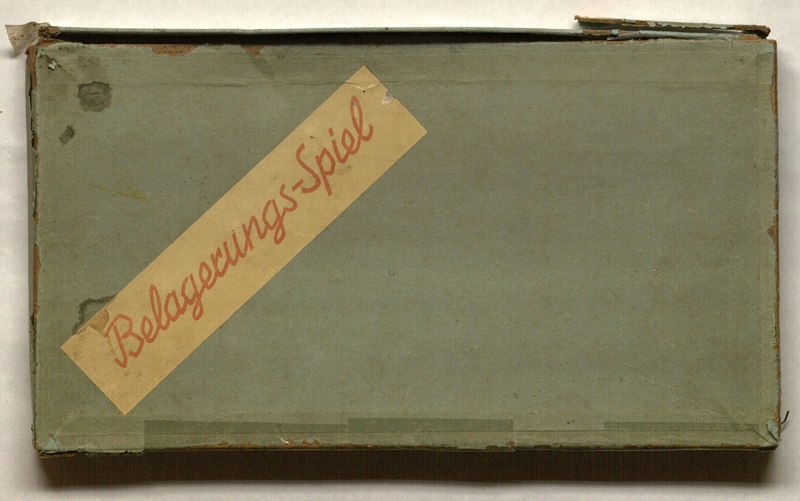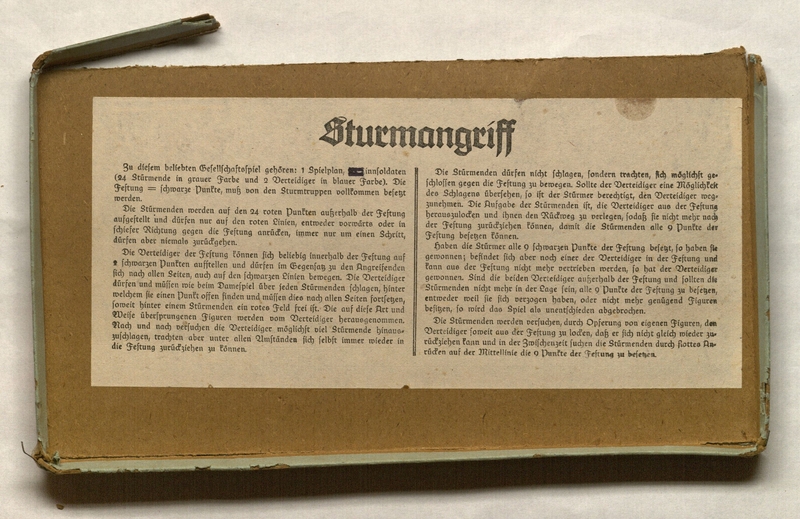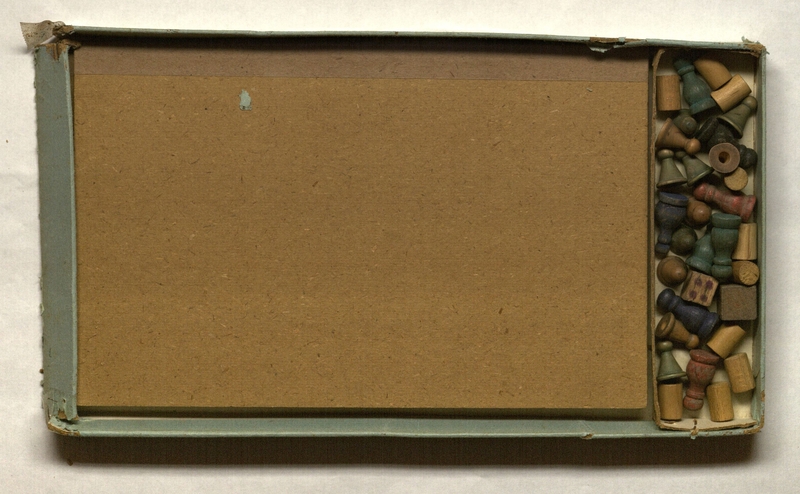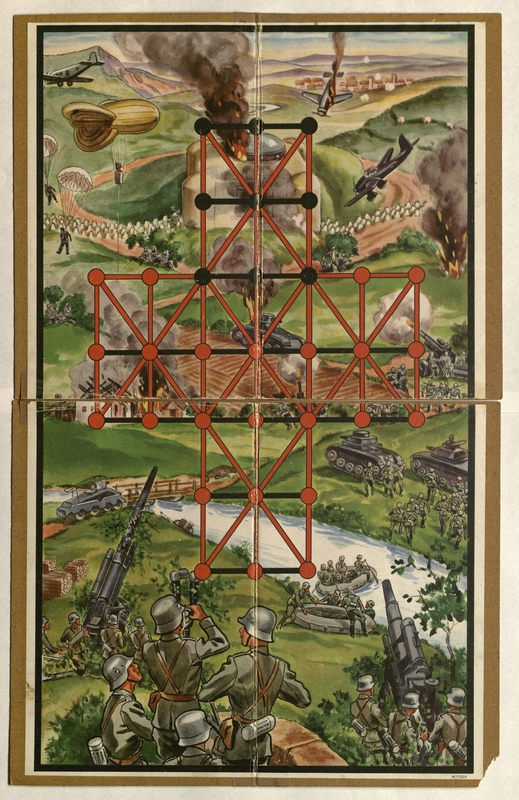Overview
- Brief Narrative
- Belagerungs-Spiel (Siege game) Sturmangriff (Assault) board game with original box, instructions, 2 dice, and 29 playing pieces produced in Nazi Germany in 1941. This version features different divisions of the Wehrmacht, the unified Armed Forces of Nazi Germany. The colorful game board has images of Army Panzers, Luftwaffe airplanes, including a Stuka dive bomber and a blimp, and paratroopers attacking and occupying a green, fertile landscape with rivers and plowed fields, with the game diagram of red and black connecting lines and intersecting dots. The siege or fortress game, a popular war game since the 18th century, features a small number of defenders who must protect the fortress from a large numbers of attackers. The defenders are allowed greater freedom of movement, while the attackers must stay on the red lines and can move only one way, forward.
- Date
-
publication/distribution:
1941
- Geography
-
manufacture:
Nuremberg (Germany)
- Credit Line
- United States Holocaust Memorial Museum Collection, Gift of Diane Mujica
- Markings
- a. lid, top exterior, white label, red ink : Belagerungs-Spiel [Siege Game]
a. lid, exterior, white label, red ink : [?]60 / [?]DEZ. / Sturmangriff [Assault]
a. lid, interior, on paper, black ink : Sturmangriff / Zu diesem beliebten Gesellschaftsspiel gehören: 1 Spielplan, [?]innsoldaten / (24 Stürmende in grauer Farbe und 2 Verteidiger in blauer Farbe). Die / Festung = schwarze Punkte, muß von den Sturmtruppen vollkommen besetzt / werden. / Die Stürmenden werden auf den 24 roten Punkte außerhalb der Festung / aufgestellet und dürfen nur auf den roten Linien, entweder vorwärts oder in / schiefer Richtung gegen die Festung anrücken, immer nur um einen Schritt, / dürfen aber niemals zurückgehen. / Die Verteidiger der Festung können sich beliebig innerhalb der Festung auf / 2 schwarzen Pünkten ausstellen und dürfen im Gegensatzt zu den Angreifenden sich nach allen Seiten, auch auf den schwarzen Linien bewegen. Die Verteidiger / dürfen und müssen wie beim Damespiel über jeden Stürmenden schlagen, hinter / welchem sie einen Punkte offen finden und müssen dies nach allen Seiten fortsetzen, / soweit hinter einen Stürmenden ein rotes Feld frei ist. Die auf diese Art / und Wiese übersprungenen Figuren werden vom Verteidiger herausgenommen. / Nach und nach versuchen die Verteidger möglichst viel Stürmende hinaus- / zuschlagen, trachten aber unter allen Umständen sich selbst immer wieder in / die Festung zurückziehen zu können. / Die Stürmenden dürfen nicht schlagen, sondern trachten, sich möglichst ge- / schlossen gegen die Festung zu bewegen. Sollte der Verteidiger eine Möglichkeit / des Schlagens übersehen, so ist der Stürmer berechtigt, den Verteidiger weg- / zunehmen. Die Aufgabe der Stürmenden ist, die Verteidiger auf der Festung / herauszulocken und ihnen den Ruckweg su verlegen, sodaß sie nicht mehr nach / der Festung zurückziehen können, damit die Stürmenden alle 9 Pünkte der / Festung besetzen können. / Haben die Stürmer alle 9 schwarzen Punkte der Festung besetzt, so haben sie / gewonnen; befindet sich aber noch einer der Verteidiger in der Festung und kann aus der Festung nicht mehr vertrieben werden, so hat der Verteidiger / gewonnen. Sind die beiden Verteidiger außerhalb der Festung und sollten die / Stürmenden nicht mehr in der Lage sein, alle 9 Punkte der Festung besetzen, / entweder weil sie sich verzogen haben, oder nicht mehr genügend Figuren / besitzen, so wird das Spiel als unentschieden abgebrochen. / Die Stürmenden werden versuchen, durch Operfung von eigenen Figuren, den / Verteidiger soweit aus der Festung zu locken, daß er sich nicht gleich wieder zu- / rückziehen kann und in der Zwischenzeit suchen die Stürmenden durch hottes An- / rücken auf der Mittellinie die 9 Punkte der Festung zu besetzen. [Assault / To this beloved siege game belongs: 1 game board, [?] soldiers (24 stormtroopers in the color gray and 2 defenders in the color blue). The fortress = black dots, must be completely occupied by the Stormtroopers. The stormtroopers are placed on the 24 red dots outside of the fortress and are allowed to go only on the red lines, advancing either forward or in a diagonal direction against the fortress, always only in one move/turn, but are not ever allowed to go backwards. The defenders of the fortress can arbitrarily XX inside the fortress on 2 black dots and are allowed in contrast to the offensive to move on all sides, including the black lines. ...]
d. bottom right, black ink : M / 1326 - Contributor
-
Manufacturer:
Verlag FSN
Physical Details
- Language
- German
- Classification
-
Toys
- Category
-
Games
- Object Type
-
Board games (lcsh)
- Physical Description
- a. Rectangular cardboard box lid for base (b) covered with faded light blue paper with a yellow paper label with the game name printed in German cursive glued diagonally on the right exterior; another label is glued on the side. Adhered to the inside of the lid is a large paper with lengthy game instructions in German fraktur text.
b. Rectangular cardboard box base for lid (a) with faded green paper glued and taped along the sides. The interior has a small rectangular closed apartment on 1 end to store the 2 dice and 29 game pieces. The game folds flat to fit into the remaining section. Both lid and base are very worn, with detached sections.
c. Rectangular upper half of a folding fiberboard game board made from 2 boards joined by seam tape. A colored drawing printed on glossy, white paper is adhered to the top. The top image contains two-thirds of a red and black playing grid of intersecting lines forming squares and triangles, joined by circles. The image features a green landscape with hills and plowed fields, under aerial attack, with a large burning structure.
d. Rectangular lower half of a folding fiberboard game board made from 2 boards joined by seam tape. A colored drawing printed on glossy, white paper is adhered to the top. This section has about one-third of the playing grid. The background image depicts a river crossing by German soldiers, tanks, and, in the foreground, a group of soldiers with antiaircraft guns surveying the scene.
e. Six-sided, unfinished wooden dice cube with faint, hand drawn pink dots with 1-6 dots on each facet.
f. Six-sided unfinished, uneven wooden dice cube with hand drawn blue and purple ink dots with 1-6 dots on each facet.
g-k. 5 light brown painted, varnished wooden game pieces with a cone shaped body and a round ball on top. The base has an extended lip and a small circular hole is drilled in the cone.
l-q. 6 light green painted, varnished wooden game pieces with a cone shaped body with a round ball on top. The base has an extended lip and a small circular hole is drilled in the cone.
r-t. 3 green painted, varnished wooden game pieces with a bulbous body, a ball shaped top, and a pedestal base.
u-v. 2 blue painted, varnished wooden game pieces with a bulbous body, a ball shaped top, and a pedestal base.
w-x. 2 red painted, varnished wooden game pieces with a bulbous body, a ball shaped top, and a pedestal base.
y. 1 black painted, varnished wooden game piece with a bulbous body, a ball shaped top and a pedestal base.
z-ai. 10 yellow painted, varnished cylindrical wooden game pieces with a flat top and bottom. - Dimensions
- a: Height: 0.750 inches (1.905 cm) | Width: 12.000 inches (30.48 cm) | Depth: 6.750 inches (17.145 cm)
b: Height: 0.875 inches (2.223 cm) | Width: 12.000 inches (30.48 cm) | Depth: 6.500 inches (16.51 cm)
c: Height: 9.500 inches (24.13 cm) | Width: 12.000 inches (30.48 cm)
d: Height: 9.500 inches (24.13 cm) | Width: 12.000 inches (30.48 cm)
e: Height: 0.500 inches (1.27 cm) | Width: 0.500 inches (1.27 cm) | Depth: 0.500 inches (1.27 cm)
f: Height: 0.500 inches (1.27 cm) | Width: 0.500 inches (1.27 cm) | Depth: 0.500 inches (1.27 cm)
g-k: Height: 0.625 inches (1.588 cm) | Width: 0.500 inches (1.27 cm) | Depth: 0.500 inches (1.27 cm)
l-q: Height: 0.625 inches (1.588 cm) | Width: 0.500 inches (1.27 cm) | Depth: 0.500 inches (1.27 cm)
r-t: Height: 1.000 inches (2.54 cm) | Width: 0.375 inches (0.953 cm) | Depth: 0.375 inches (0.953 cm)
u-v: Height: 1.000 inches (2.54 cm) | Width: 0.375 inches (0.953 cm) | Depth: 0.375 inches (0.953 cm)
w-x: Height: 1.000 inches (2.54 cm) | Width: 0.375 inches (0.953 cm) | Depth: 0.375 inches (0.953 cm)
y: Height: 1.000 inches (2.54 cm) | Width: 0.500 inches (1.27 cm) | Depth: 0.500 inches (1.27 cm)
z-ai: Height: 0.500 inches (1.27 cm) | Width: 0.375 inches (0.953 cm) | Depth: 0.375 inches (0.953 cm) - Materials
- a : cardboard, paper, adhesive, ink
b : cardboard, paper, ink, pressure-sensitive tape
c : fiberboard, paper, ink
d : fiberboard, paper, ink
e : wood, pigment
f : wood, ink
g-ai : wood, paint, varnish
Rights & Restrictions
- Conditions on Access
- No restrictions on access
- Conditions on Use
- No restrictions on use
Keywords & Subjects
Administrative Notes
- Legal Status
- Permanent Collection
- Provenance
- The board game was donated to the United States Holocaust Memorial Museum in 2013 by Diane Mujica.
- Funding Note
- The cataloging of this artifact has been supported by a grant from the Conference on Jewish Material Claims Against Germany.
- Record last modified:
- 2022-08-22 07:00:27
- This page:
- https://collections.ushmm.org/search/catalog/irn50725







